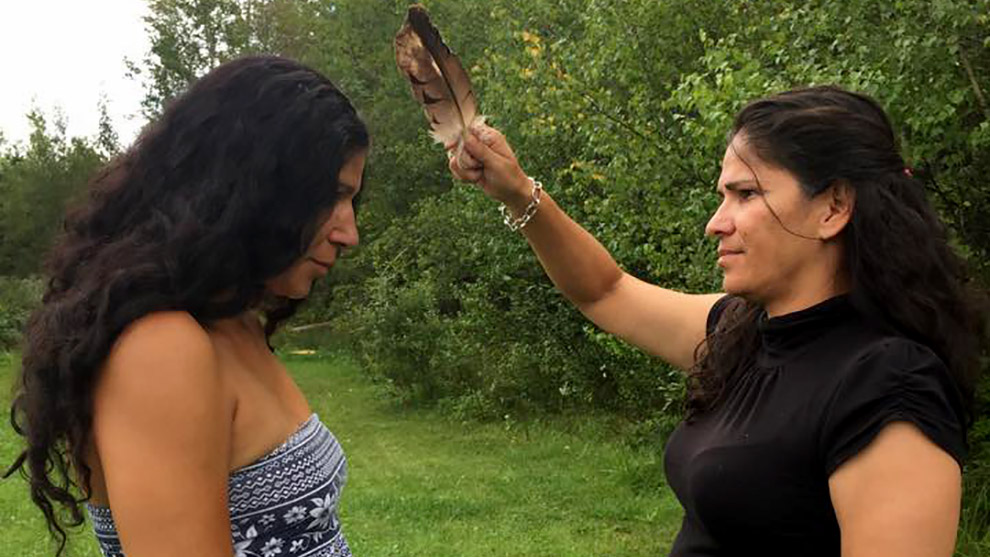Mental Health
New service integrates counselling and traditional healing
Robyn Hazard and Mindy Gallant-Zwicker offer on reserve crisis counselling services to all aboriginal communities across the province

caption
Robyn Hazard and Mindy Gallant-Zwicker combine professional counselling services with traditional aboriginal healing practices at Alsusuti Aboriginal Crisis Counselling Services.
caption
Robyn Hazard and Mindy Gallant-Zwicker combine professional counselling services with traditional aboriginal healing practices at Alsusuti Aboriginal Crisis Counselling Services.Robyn Hazard left her job frustrated in 2011. She had been working at an agency providing support to aboriginal communities.
Hazard says there were too many policies and restrictions in the agency. She left with one goal; to earn her master’s degree in social work and come back into the community.
“I wanted to offer service that was less oppressive, but that would still reach the same goal of providing help and assistance to communities,” says Hazard. Related stories
Six weeks ago Hazard opened Alsusuti Aboriginal Crisis Counselling Services with Mindy Gallant-Zwicker.
The service specializes in on-reserve counselling across all aboriginal communities in Nova Scotia. Those living on-reserve can call the crisis counselling centre and book an appointment for Hazard and Gallant-Zwicker to visit the community.
According to Canada’s 2011 National Household Survey, 68 per cent of First Nations people live on-reserve in Nova Scotia.
Hazard says it’s the first service in the region to offer professional counselling services integrated with traditional healing practices.
“People are really excited about the fact that they finally have something that’s in-community that offers all of the components they’ve been asking for in-community for a long time,” says Hazard.
It was important for the service to incorporate that cultural component into the counselling.
Hazard says counselling is more accepted in communities, people feel more comfortable with it and are more open to trusting and opening up to counsellors.
“There’s a lot of mistrust in aboriginal communities when it comes to telling people outside of your community your concerns and what your issues may be, because of fear of getting involved with the agency or with the police,” says Hazard. “So it provides a little bit more safety or a feeling of safety.”
National suicide prevention strategy
Reports from Statistics Canada and The First Nations Information Governance Centre have found that 20 per cent of indigenous people have thought about suicide in their lifetime. Both studies estimated that roughly 10 per cent of non-aboriginal people have reported thoughts of suicide.
Health-care professionals across the country have been calling on Ottawa to create a national suicide prevention strategy.
Allison Crawford, an assistant professor in the University of Toronto’s faculty of medicine, says Canada is one of the few developed countries that doesn’t have doesn’t have a national suicide prevention strategy – and that’s a big problem.
In 2012 the federal government passed the Federal Framework for Suicide Prevention Act. The act requires Ottawa to hold public consultations with non-government organizations and relevant provincial, territorial and federal government departments and agencies to gather information on suicide.
It also states the federal government must report on its findings from the public consultations within the first four years of the act. As the act became law in December 2012, a report is expected to be released later this year.
Crawford says the framework is a start, but a strategy is still needed.
“People are still unclear about what the gap will be between a framework and a strategy,” says Crawford. “A strategy is a little bit different in that it has accountability mechanisms built in and it usually has money associated with it.”
She says to date there has been no money allocated to the federal framework and suggests a strategy could help co-ordinate services.
‘A lack of services available for aboriginals’
Hazard agrees that more needs to be done.
“One of the key factors in suicide prevention is making sure that people have better access to resources and that there is more knowledge about the resources that are available,” says Hazard.
She warns getting information to the target population can be challenging.
“Accessing clients is part of the barrier,” says Hazard. “For example, not everyone has access to the Internet. Not everyone can call on their cellphones; they can only text. So even if they see the information they can’t access you.”
Crawford says she’s pleased that Hazard and Gallant-Zwicker have started the counselling service, but says it points to a bigger problem.
“It speaks to the system that this is having to be developed almost as a non-governmental organization because an equivalent service doesn’t exist within our current healthcare framework,” says Crawford.
For Hazard and Gallant-Zwicker the focus is supporting communities.
“There is a lack of services available for aboriginals. They pass and exceed that crisis point and then reach that point of suicide, unfortunately,” said Hazard.
Right now it’s about spreading the word.
“The goal for us is to get our information to the communities as well as we can so people know that the service is there and use it. Because we may exist, but we need for people to know we exist,” says Hazard.
About the author
Kathleen Napier
Kathleen Napier is currently completing her Master of Journalism (Data and Investigative) at the University of King’s College in Halifax. Special...

R
Robyn Hazard
w
w